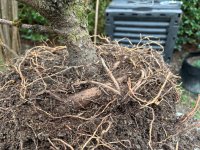Ireland is world famous for it's rain. No problem for the tree being root pruned in the rain. much more of a problem for the person doing the root pruning.
I can understand your reluctance to root prune after a failure. the question is whether the previous problem was down to the root pruning or something coincidental that you have not considered.
HBR stands for Half Bare Root and includes the entire root ball, not just the surface. Looking at the pictures I'd estimate you did maybe 1/0 bare root? looks like the entire lower part of the original root ball is untouched in the photos but maybe that's what you did after the photos? at that rate it might take 5-10 year for you to deal with that thick root and most of the other problem roots here.
Not only can you half bare root pines (remove half the potting soil) you can also safely remove up to half the existing roots without affecting the tree and I'd consider that quite conservative.
I have not yet tried Fall root reduction on pines as I'm accustomed to doing Spring root pruning and seem to be able to get all my trees done in winter/spring. I know some very good growers do fall root prune so I take their word for it's safety and effectiveness. I just cannot say how much is safe or not safe as I have no personal experience.
It may be possible to use the thick root in the design but I would not make that call until I can see more of the real roots, not just a few little floaters on the surface.
Not sure whether that circling root would be considered a 'tap root'. Trees rarely have a 'tap root'. The initial seed root goes down but soon splits into many lateral roots and the initial down roots disappear. My guess is that's just one of the early lateral roots that was curled around in a smaller pot when this tree was much younger and for some reason it has grown a bit better than the others though we can't yet see any other lateral roots growing from the trunk. It is not unusual to come across a whole nest of these curled roots as you remove the surface soil but hope that's not the case this time.






